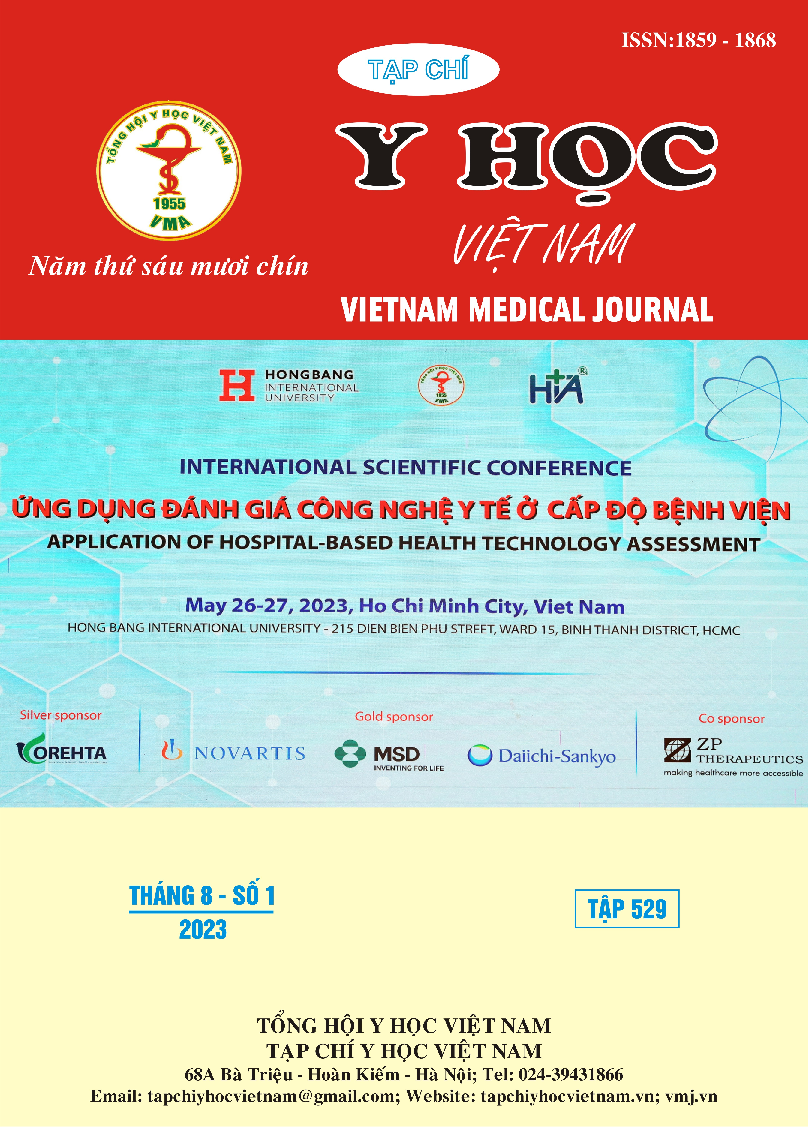INITIAL DETERMINATION OF THE PARAMETERS OF ARTIFICIAL NEURAL NETWORK IN ESTIMATED GLOMERULAR FILTRATION RATE
Main Article Content
Abstract
Objective: To find closely correlated parameters using an artificial neural network model that learns from eGFR formulas in biochemical analytes (glucose, albumin, protein, uric acid, urea, creatinine in blood and creatinine in urine) and biological parameters (age, sex, BMI, blood pressure, height, weight, waist circumference, buttock circumference) as the basis for building the next ANN models. Research method: Cross-sectional description of volunteers living in Ho Chi Minh City and Vung Tau, subjects with chronic kidney disease at kidney clinic, hospital of University of Medicine and Pharmacy of Ho Chi Minh City. Ho Chi Minh City basis 2. Survey of age, gender, height, weight, blood pressure, waist circumference, buttock circumference, BMI, glucose, urea, creatinine, protein, albumin uric acid in blood, and creatinine in water 24 hour urine. Results: There were 161 participants, including 115 healthy volunteers and 46 patients with chronic kidney disease. Determine 3 parameters of protein, serum creatinine, and weight that are closely correlated with the artificial neural network from established glomerular filtration rate estimation formulas. Conclusion: Using 3 analytes that are closely correlated with eGFR, namely protein, serum creatinine, and weight, data can be used to build an ANN model in estimating glomerular filtration rate
Article Details
Keywords
artificial neural network, estimated glomerular filtration rate, CKD-EPI, MDRD.
References
2. Liu X, Li NS, Lv LS, Huang JH, Tang H, Chen JX, et al. A comparison of the performances of an artificial neural network and a regression model for GFR estimation. Am J Kidney Dis. 2013;62(6):1109-15. Epub 2013/09/10. doi: 10.1053/j.ajkd.2013.07.010. PubMed PMID: 24011972.
3. Zhao L, Zhang JJ, Tian X, Huang JM, Xie P, Li XZ. The ensemble learning model is not better than the Asian modified CKD-EPI equation for glomerular filtration rate estimation in Chinese CKD patients in the external validation study. BMC Nephrol. 2021;22(1):372. Epub 2021/11/11. doi: 10.1186/s12882-021-02595-5. PubMed PMID: 34753430; PubMed Central PMCID: PMCPMC8579608.
4. Li N, Huang H, Qian H-Z, Liu P, Lu H, Liu X. Improving accuracy of estimating glomerular filtration rate using artificial neural network: model development and validation. Journal of Translational Medicine. 2020;18(1):120. doi: 10.1186/s12967-020-02287-y.
5. Liu X, Li N, Lv L, Fu Y, Cheng C, Wang C, et al. Improving precision of glomerular filtration rate estimating model by ensemble learning. J Transl Med. 2017;15(1):231. Epub 2017/11/11. doi: 10.1186/s12967-017-1337-y. PubMed PMID: 29121946; PubMed Central PMCID: PMCPMC5679185.
6. Levey AS, Stevens LA, Schmid CH, Zhang YL, Castro AF, 3rd, Feldman HI, et al. A new equation to estimate glomerular filtration rate. Ann Intern Med. 2009;150(9):604-12. Epub 2009/05/06. doi: 10.7326/0003-4819-150-9-200905050-00006. PubMed PMID: 19414839; PubMed Central PMCID: PMCPMC2763564.
7. Liu X, Pei X, Li N, Zhang Y, Zhang X, Chen J, et al. Improved glomerular filtration rate estimation by an artificial neural network. PloS one. 2013;8(3):e58242-e. Epub 2013/03/13. doi: 10.1371/journal.pone.0058242. PubMed PMID: 23516450.
8. Vũ Quang Huy, Văn Hy Triết, Lê Thị Mỹ Dạ, Lê Thị Mai Dung. Khảo sát mối liên hệ một số xét nghiệm với chỉ số lọc cầu thận thiết lập. Tạp chí Y học Thành phố Hồ Chí Minh chuyên đề Điều dưỡng - Kỹ thuật Y học. 2020;tập 24 (5),:171-7.
9. Chang TJ, Zheng CM, Wu MY, Chen TT, Wu YC, Wu YL, et al. Relationship between body mass index and renal function deterioration among the Taiwanese chronic kidney disease population. Sci Rep. 2018;8(1):6908. Epub 2018/05/04. doi: 10.1038/s41598-018-24757-6. PubMed PMID: 29720598; PubMed Central PMCID: PMCPMC5932053.


